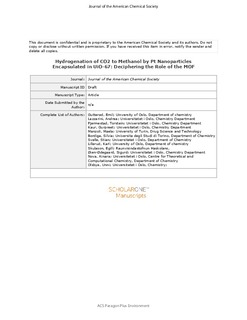| dc.contributor.author | Gutterød, Emil Sebastian | |
| dc.contributor.author | Lazzarini, Andrea | |
| dc.contributor.author | Fjermestad, Torstein | |
| dc.contributor.author | Kaur, Gurpreet | |
| dc.contributor.author | Manzoli, Maela | |
| dc.contributor.author | Bordiga, Silvia | |
| dc.contributor.author | Svelle, Stian | |
| dc.contributor.author | Lillerud, Karl Petter | |
| dc.contributor.author | Skúlason, Egill | |
| dc.contributor.author | Øien-Ødegaard, Sigurd | |
| dc.contributor.author | Nova, Ainara | |
| dc.contributor.author | Olsbye, Unni | |
| dc.date.accessioned | 2020-01-24T14:39:47Z | |
| dc.date.available | 2020-01-24T14:39:47Z | |
| dc.date.created | 2020-01-20T16:45:34Z | |
| dc.date.issued | 2019 | |
| dc.identifier.citation | Journal of the American Chemical Society. 2020, 142 999-?. | nb_NO |
| dc.identifier.issn | 0002-7863 | |
| dc.identifier.uri | http://hdl.handle.net/11250/2637885 | |
| dc.description.abstract | Metal–organic frameworks (MOFs) show great prospect as catalysts and catalyst support materials. Yet, studies that address their dynamic, kinetic, and mechanistic role in target reactions are scarce. In this study, an exceptionally stable MOF catalyst consisting of Pt nanoparticles (NPs) embedded in a Zr-based UiO-67 MOF was subject to steady-state and transient kinetic studies involving H/D and 13C/12C exchange, coupled with operando infrared spectroscopy and density functional theory (DFT) modeling, targeting methanol formation from CO2/H2 feeds at 170 °C and 1–8 bar pressure. The study revealed that methanol is formed at the interface between the Pt NPs and defect Zr nodes via formate species attached to the Zr nodes. Methanol formation is mechanistically separated from the formation of coproducts CO and methane, except for hydrogen activation on the Pt NPs. Careful analysis of transient data revealed that the number of intermediates was higher than the number of open Zr sites in the MOF lattice around each Pt NP. Hence, additional Zr sites must be available for formate formation. DFT modeling revealed that Pt NP growth is sufficiently energetically favored to enable displacement of linkers and creation of open Zr sites during pretreatment. However, linker displacement during formate formation is energetically disfavored, in line with the excellent catalyst stability observed experimentally. Overall, the study provides firm evidence that methanol is formed at the interface of Pt NPs and linker-deficient Zr6O8 nodes resting on the Pt NP surface. | nb_NO |
| dc.language.iso | eng | nb_NO |
| dc.publisher | American Chemical Society | nb_NO |
| dc.subject | Platinum | nb_NO |
| dc.subject | Alcohols | nb_NO |
| dc.subject | Metal organic frameworks | nb_NO |
| dc.subject | Catalysts | nb_NO |
| dc.subject | Hydrogenation | nb_NO |
| dc.title | Hydrogenation of CO2 to Methanol by Pt Nanoparticles Encapsulated in UiO-67: Deciphering the Role of the Metal−Organic Framework | nb_NO |
| dc.type | Journal article | nb_NO |
| dc.type | Peer reviewed | nb_NO |
| dc.description.version | acceptedVersion | nb_NO |
| dc.rights.holder | “This document is the unedited Author’s version of a Submitted Work that was subsequently accepted for publication in Journal of the American Chemical Society, copyright © American Chemical Society after peer review. To access the final edited and published work see http://dx.doi.org/10.1021/jacs.9b10873 | nb_NO |
| dc.source.pagenumber | 999-1009 | nb_NO |
| dc.source.volume | 142 | nb_NO |
| dc.source.journal | Journal of the American Chemical Society | nb_NO |
| dc.source.issue | 2 | nb_NO |
| dc.identifier.doi | 10.1021/jacs.9b10873 | |
| dc.identifier.cristin | 1778336 | |
| dc.relation.project | Nordforsk: 85378 | nb_NO |
| dc.relation.project | Norges forskningsråd: 250044 | nb_NO |
| dc.relation.project | Notur/NorStore: nn4654k | nb_NO |
| dc.relation.project | Norges forskningsråd: 262695 | nb_NO |
| dc.relation.project | Notur/NorStore: nn4683k | nb_NO |
| dc.relation.project | Norges forskningsråd: 250795 | nb_NO |
| cristin.unitcode | 7401,80,40,0 | |
| cristin.unitname | Prosessteknologi | |
| cristin.ispublished | true | |
| cristin.fulltext | preprint | |
| cristin.qualitycode | 2 | |
